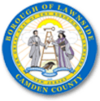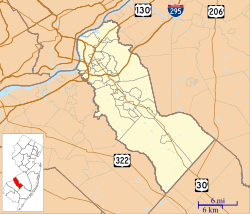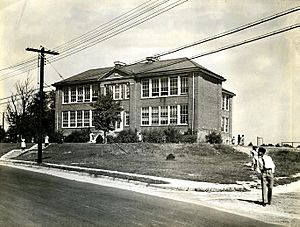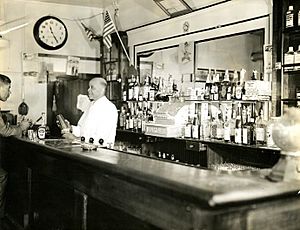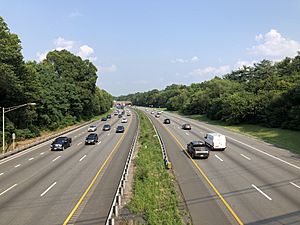Lawnside, New Jersey facts for kids
Quick facts for kids
Lawnside, New Jersey
|
||
|---|---|---|
|
Borough
|
||
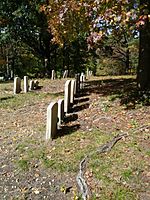
Mount Peace Cemetery and Funeral Directing Company Cemetery
|
||
|
||
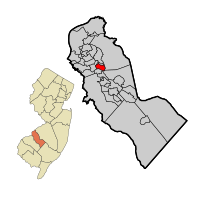
Location of Lawnside in Camden County highlighted in red (right). Inset map: Location of Camden County in New Jersey highlighted in orange (left).
|
||

Census Bureau map of Lawnside, New Jersey
|
||
| Country | ||
| State | ||
| County | Camden | |
| Incorporated | April 20, 1926 | |
| Government | ||
| • Type | Borough | |
| • Body | Borough Council | |
| Area | ||
| • Total | 1.43 sq mi (3.70 km2) | |
| • Land | 1.43 sq mi (3.70 km2) | |
| • Water | 0.00 sq mi (0.00 km2) 0.00% | |
| Area rank | 459th of 565 in state 25th of 37 in county |
|
| Elevation | 85 ft (26 m) | |
| Population
(2020)
|
||
| • Total | 2,955 | |
| • Estimate
(2023)
|
3,301 | |
| • Rank | 451st of 565 in state 28th of 37 in county |
|
| • Density | 2,065.8/sq mi (797.6/km2) | |
| • Density rank | 289th of 565 in state 30th of 37 in county |
|
| Time zone | UTC−05:00 (Eastern (EST)) | |
| • Summer (DST) | UTC−04:00 (Eastern (EDT)) | |
| ZIP Code |
08045
|
|
| Area code(s) | 856 exchanges: 310, 546, 547, 573, 672 | |
| FIPS code | 3400739420 | |
| GNIS feature ID | 0885274 | |
Lawnside is a small town, called a borough, in Camden County, New Jersey. It was started in 1840 and became an official town in 1926. Lawnside is special because it was the first independent town in the northern United States where African Americans governed themselves.
A big United Parcel Service (UPS) building is located in Lawnside. In 2020, about 2,955 people lived in the borough.
Contents
History of Lawnside
Lawnside has been a home for African Americans since the late 1700s. Early on, people gathered for Methodist church services. In 1811, Bishop Richard Allen started the local African Methodist Episcopal Church (AME). This church, now called Mount Pisgah AME Church, focused on ending slavery and fighting for civil rights.
Many freed slaves found safety and help near Quaker allies in nearby Haddonfield. In 1840, these allies bought land to sell cheaply to African Americans. The community was first called "Free Haven" because it was an important stop on the Underground Railroad. This was a secret network that helped slaves escape to freedom. The Peter Mott House, a famous Underground Railroad refuge, was saved in 1992 to protect this history.
From Snow Hill to Lawnside
After the Civil War, the village was known as "Snow Hill." Later, it was called "Lawnton." When a train station was built in 1907, the town became known as Lawnside. This name might have come from a large lawn at the station or because it was on the "Lawnton side" of the tracks.
In 1919, John Lawson, a hero from the Civil War who received the Medal of Honor, was buried in Mount Peace Cemetery in Lawnside. He might have had family there, or it could be because some cemeteries in Pennsylvania did not allow Black veterans to be buried.
Becoming a Self-Governing Town
On March 24, 1926, the Governor of New Jersey signed a law that made Lawnside its own borough. This also included parts of the nearby town of Barrington. A month later, on April 20, 1926, Lawnside officially became the first independent, self-governing African American community north of the Mason–Dixon line.
Even though banks often made it hard for African Americans to get loans, Lawnside's new status helped its residents buy homes. Local companies also helped people get mortgages.
A Hub for Music and Culture
In the 1930s, Lawnside became famous for its lively jazz and barbecue scene. Places like the Cotton Club and the Hi-Hat Club attracted visitors from all over. These clubs were special because they allowed famous African American artists to perform when many other places did not. Stars like Sarah Vaughan, Ella Fitzgerald, Duke Ellington, and Billie Holiday played here. Even champion boxers like Joe Louis visited.
Civil Rights and Community Pride
During the 1960s, young people in Lawnside were inspired by the Civil Rights and Black power movements. They protested against unfair treatment at their regional high school. These protests led to changes in the school, more student representation, and new courses about Black history.
On April 9, 1968, just days after Martin Luther King Jr. was assassinated, Lawnside leaders made his birthday a holiday. This was the first time any government in the United States did this.
Geography
Lawnside covers about 1.43 square miles (3.70 square kilometers) of land. It is surrounded by other towns in Camden County, New Jersey. These include Barrington, Cherry Hill, Haddonfield, Magnolia, Somerdale, Tavistock, and Voorhees Township.
Population Information
| Historical population | |||
|---|---|---|---|
| Census | Pop. | %± | |
| 1930 | 1,379 | — | |
| 1940 | 1,270 | −7.9% | |
| 1950 | 1,566 | 23.3% | |
| 1960 | 2,155 | 37.6% | |
| 1970 | 2,757 | 27.9% | |
| 1980 | 3,042 | 10.3% | |
| 1990 | 2,841 | −6.6% | |
| 2000 | 2,692 | −5.2% | |
| 2010 | 2,945 | 9.4% | |
| 2020 | 2,955 | 0.3% | |
| 2023 (est.) | 3,301 | 12.1% | |
| Population sources:1930–2000 1930 1940–2000 2000 2010 2020 |
|||
In 2020, the population of Lawnside was 2,955 people. This was a small increase from 2,945 people in 2010. Most people in Lawnside are Black or African American. There are also people of White, Asian, and other backgrounds living in the town. About 11.5% of the population is Hispanic or Latino.
Education
Lawnside has its own school district, the Lawnside School District. Students from kindergarten through eighth grade attend Lawnside Public School. In the 2018–19 school year, there were 321 students and 31 teachers, meaning about 10 students per teacher.
For high school, students from Lawnside go to Haddon Heights High School. This school also serves students from Haddon Heights and Barrington. In 2018–19, the high school had 906 students.
Transportation
Lawnside has many roads for getting around. Major highways like the New Jersey Turnpike and Interstate 295 pass through the borough. However, the Turnpike does not have an exit directly in Lawnside. U.S. Route 30, also known as White Horse Pike, also runs through the town.
NJ Transit offers bus service in Lawnside. You can take a bus to nearby towns like Turnersville and Camden. From Camden, you can connect to other buses and trains that go to Philadelphia.
Notable People
Many interesting people have lived in or are connected to Lawnside:
- Horace J. Bryant (1909–1983), the first African American to be a part of a State Cabinet in New Jersey.
- Wayne R. Bryant (born 1947), a former member of the New Jersey General Assembly and State Senate.
- Ray Fisher (born 1988), an actor known for playing Cyborg in the movie Batman v Superman: Dawn of Justice.
- Steve Israel (born 1969), a football player who played for 10 seasons in the NFL.
- John Lawson (1837–1919), a hero who received the Medal of Honor, is buried in Lawnside.
- Ryan Roberts (born 1980), a former football player for the Notre Dame Fighting Irish football team.
- Sherron Rolax, known for a civil rights case in 1996.
- Charity Still (around 1775–1857), an abolitionist who escaped slavery.
- William Still (1821–1902), a famous abolitionist who helped many slaves escape to freedom. He lived in Lawnside with his family.
See also
 In Spanish: Lawnside para niños
In Spanish: Lawnside para niños


